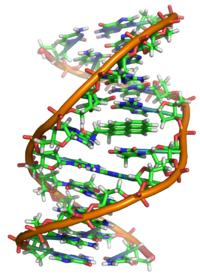
Photo from wikipedia
The active DNA demethylation mechanism involves 5-methylcytosine (5-mCyt) enzymatic oxidation with the subsequent formation of 5-hydroxymethylcytosine (5-hmCyt), which can be further oxidized to 5-formylcytosine (5-fCyt) and 5-carboxylcytosine (5-caCyt). The products… Click to show full abstract
The active DNA demethylation mechanism involves 5-methylcytosine (5-mCyt) enzymatic oxidation with the subsequent formation of 5-hydroxymethylcytosine (5-hmCyt), which can be further oxidized to 5-formylcytosine (5-fCyt) and 5-carboxylcytosine (5-caCyt). The products of active DNA demethylation are released into the bloodstream and eventually also appear in urine. We used online two-dimensional ultraperformance liquid chromatography with tandem mass spectrometry (2D-UPLC-MS/MS) to compare DNA methylation marks and 8-oxo-2′-deoxyguanosine (8-oxodG) in colorectal cancer and pre-cancerous condition in urine. The study included four groups of subjects: healthy controls, patients with inflammatory bowel disease (IBD), persons with adenomatous polyps (AD), and individuals with colorectal cancer (CRC). We have found that the level of 5-fCyt in urine was significantly lower for CRC and polyp groups than in the control group. The level of 5-hmCyt was significantly higher only in the CRC group compared to the control (2.3 vs. 2.1 nmol/mmol creatinine). Interestingly, we have found highly statistically significant correlation of 5-hydroxymethyluracil with 5-hydroxymethylcytosine, 5-(hydroxymethyl)-2′-deoxycytidine, 5-(hydroxymethyl)-2′-deoxyuridine, and 5-methyl-2′-deoxycytidine in the CRC patients’ group.
Journal Title: International Journal of Molecular Sciences
Year Published: 2022
Link to full text (if available)
Share on Social Media: Sign Up to like & get
recommendations!